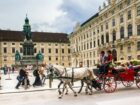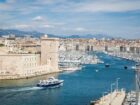If you’re traveling to Cambodia, you’ll likely be visiting Phnom Penh or Siem Reap. If you’re staying one week or more, you might visit both places. Should you spend most of your time in Phnom Penh or Siem Reap?
Siem Reap is a resort town close to the ruins of Angkor, center of the ancient Khmer kingdom (9th to 15th century) and composed of a series of well-preserved and massive temples. The Siem Reap town itself is modern and attractive for tourists with nice hotels, restaurants, and shops.
Phnom Penh is the country’s capital with 1.5M inhabitants, some quality tourist attractions, historical areas, and a nice and relaxing atmosphere by day and by night. Most travelers recommend spending at least 4 days in Siem Reap to visit the incredible ancient sights, but also 2 -3 days in Phnom Penh to really immerse and get a good feel of Cambodia’s recent history and present through its museums, monuments, and interesting neighborhoods.
Table of Contents
Siem Reap or Phnom Penh: what travelers say
- Both Siem Reap and Phnom Penh are worth visiting and you should try to combine them on the same trip if possible. Travelers often suggest visiting Phnom Penh before Siem Reap for a better understanding of Cambodia’s present and past.
- If you spend a week or more visiting both places, most people recommend staying 2 or 3 nights in Phnom Penh and at least 4 nights in Siem reap. If they had to choose only one, most travelers would choose Siem Reap because the Angkor Temples are just too important to miss and there’s nothing quite like them in the world. Angkor Wat is the primary reason for most people going to Cambodia.
- Siem Reap is relaxed, walkable, tourist-driven town. The number of archeological sites to visit is astounding. The town is home to the UNESCO Heritage Angkor Temples, the most important being the Wat Temple and the Thom royal city ruins. Siem Reap also has a really interesting countryside. You can spend 2 weeks and still not see everything.
- Phnom Penh is the country’s bustling capital city and the seat of government. It’s very busy and with nightmare traffic. Travelers, however, report fewer tourist hassles than in Siem Reap. The main sights include the National Museum, which you should visit prior to travel to Siem Reap for historical context, and the Royal Palace.
- The genocide sites in Pnom Penh are very moving, but some feel they are important for a good understanding of the Cambodian history. From the capital, there are many other places of interest you can day-trip to, such as Chisor and Oudongk, which travelers ignore too often.
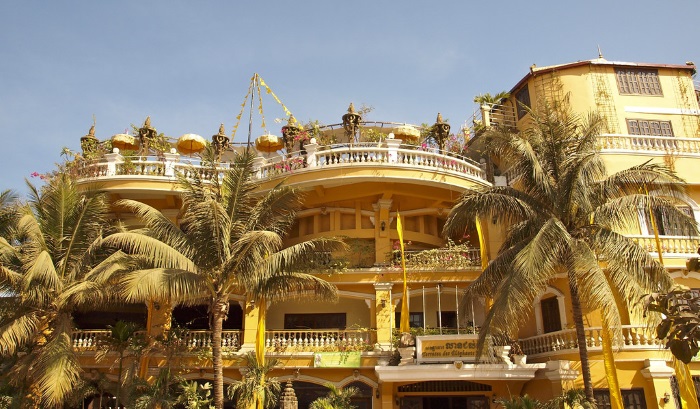
Siem Reap or Phnom Penh: access and transportation
Both destinations have direct flights connecting from other SouthEast Asian main cities and from Tokyo or Beijing. Open-jaw flights make it possible to arrive in Phnom Penh and depart from Siem Reap.
If you are traveling long distances such as from the U.S East Coast, you’ll certainly need a day to rest, recover and settle in the time zone and weather.
You can connect both cities by bus along Highway 6 via k. Thom and k. Cham., which takes between 6 and 7 hours and is really cheap. Along the way, you’ll have a taste of real Cambodia. Avoid night trips because they can be dangerous.
Taxis are more expensive but faster and more comfortable. You can also choose to travel by boat, which is operational most of the year and allows you to see coastal villages.
There are direct one-way flights between both Phnom Penh and Siem Reap daily through Lanmei Airlines and Cambodia Angkor Air.
Once you reach the Siem Reap airport, you can take a taxi or tuk-tuk for around 10 USD to the city center. They’re also the best way to get around town and for getting to the temple. Alternatively, you can rent an air-conditioned taxi or a bike.
Siem Reap or Phnom Penh: sights and culture
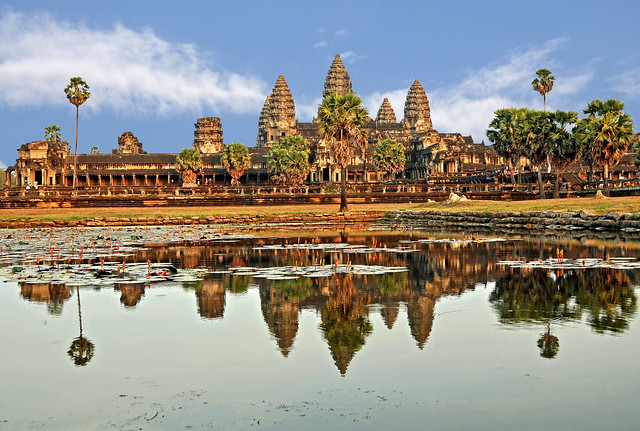
Siem Reap has one of the largest religious complex in the world, as well as the 12th century Angkor royal city, the two main reasons for visiting Siem Reap.
Angkor Wat is the most important and impressive temple. It’s best visited at sunset or sunrise to avoid crowds and best connect with the energy. Angkor Thom is another major temple featuring giant stone heads. Banteay Srei (dedicated to Shiva) and Pre Rup are smaller. A single ticket gives you access to all the temples for a given number of days.
There are other temples of interest to visit outside of Siem Reap such as Kho Ker and Prasat Preah Vihear.
Besides the temples, Siem Reap also has a good War Museum and the Angkor National Museum which features Khmer artifacts including 1,000 Buddha statues and images.
In Phnom Penh, the main sights include the Silver Pagoda, the Royal Palace, the riverfront area, the Wat Phnom temple, and the National Museum. The 88-foot pagoda of 14th-century Buddhist temple Wat Phnom overlooks the city on a hilltop.
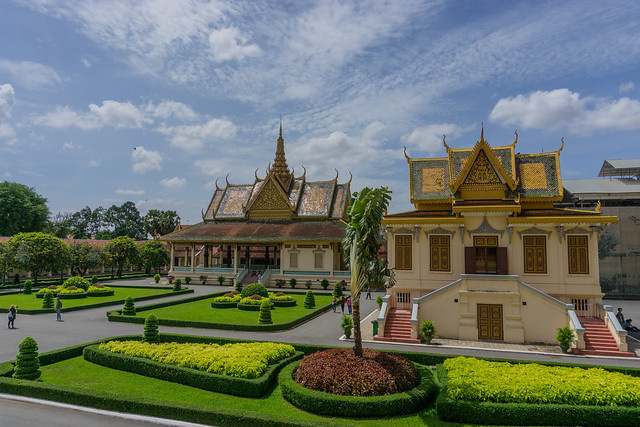
Sitting at the intersection of the Mekong and Tonlé Sap rivers, Phnom Penh has a nice walkable riverfront lined with parks and places for dining and having a drink. The river runs parallel to the main tourist area (called the Riverside), with frequent sunset cruises running daily on the Tonle Sap.
The city has an extensive Art Deco central market well worth a visit. The French colonial area is located in the Northern part of the city near the Wat Phnom temple, revolving around the 19th century Place de la Poste (French central post office, recently renovated).
The Neak Banh Teuk Park hosts morning and evening aerobics classes, people playing Chinese hacky sack, and elderly walkers.
Phnom Penh also has the tragic Tuol Sleng genocide Museum, and some travelers also visit the Cheong Ek killing fields outside the city (not to everyone’s taste). These are not fun visits but they can help some visitors understand contemporary Cambodia.
Siem Reap or Phnom Penh: food & nightlife
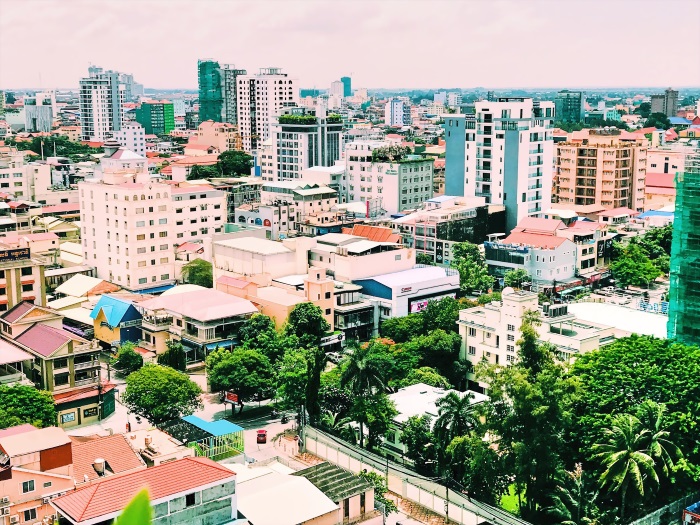
Siem Reap has an overwhelming choice of restaurants, many of which good. The downtown area is often overrun with tourists and backpacker-style nightlife. The Angkor Night Market and the Old Market are vibrant places selling souvenirs, spices, books, etc.
The French Quarter has many trendy restaurants. Pub Street is where a lot of the animation takes place at night.
In Phnom Penh, many cafes, restaurants, and boutiques concentrate around lively Street 240. There are excellent Western, South Asian, and Middle-Eastern restaurants offering authentic food at very affordable prices. Many coffee shops and casual food places have a relaxing chill-out type atmosphere with wi-fi. There you can meet and chat with friendly locals.
The Riverside area is often considered a tourist trap with all sorts of vendors trying to sell you things.
There are quite a few fine restaurants in Phnom Penh, including Malis, Romdeng (in a colonial villa, among the best in town), Mok Mony, Armand’s (intimate French Bistrot). The historic Raffles Hotel Le Royal has the reputable Le Royal Restaurant and The Elephant Bar with its astonishing 1400 elephants decor. The old colonial area has more fine dining places.
In Phnom Penh, you’ll also find several large and cheap markets. The Central Market is hosted in a 1930s Art Deco structure and offers jewelry, flowers, and clothing. The O Russei market is a three-story building with all sorts of things including food specialties and clothing. The Toul Tom Pong Market (Russian Market) is a 15-minute drive away and also has a wide range of products.
When it comes to pubs and cocktail bars in Phnom Penh, many are located at the intersection of Streets 51 and 178, where the expat crowd hands out late at night. French-run Bouchon and black-and-white themed dive bar Zeppelin Café are also popular places for a drink.
Quality Khmer songs and dance shows take place several nights per week in the garden of the National Museum in a century-old building.
Siem Reap or Phnom Penh: lodging
In Siem Reap you can find many boutique hotels, spas, large resorts, and shopping galleries. A double room close to the temples can cost around 25 USD per night. Choose a place with a swimming pool to chill out and relax after the full-day trekking.
In Phnom Penh, avoid in the riverside area and its aggressive touts. There are many nice small hotels and guesthouses in other areas.
Travelers often recommend the area close to Boeung Keng Kang Market, e.g. the Rambutan Hotel or the Teav Hotel. Europeans often choose the Plantation, a renovated 70-room with a delightful pool across three historic buildings. The Raffles Hotel Le Royal is a classic and upscale option with almost a century of history. There are also many small hotels and guesthouses in the city.
Siem Reap or Phnom Penh: day trips
When traveling between Phnom Penh and Siem Reap, you can spend a night or two in Kampong Chnang where you can visit floating villages. You can stop in the Chong Kneas (touristy) and Kampong Phluk villages – the latter is constructed on high stilts since it gets flooded in the rainy season.
Another option between both destinations is Battambang, a nice city with colonial buildings where you can enjoy some countryside or visit the southern hill temples, different than Angkor Wat ones, but also very scenic.
From Siem Reap, you can visit the Phnom Kulen National Park (1-hour tuk-tuk ride) or the Sombor Pre Kuk, a provincial town with rural communities, very lively. You can also take day trips to the Kho Ker and Prasat Preah Vihear temples.
From Phnom Penh, Chisor Mountain and Ou Dong are fascinating temples to visit, though the countless stairs to climb to the top can be a challenge.
For something different, you can go south to the Kep and Kampot areas: not many tourists, good places to relax and unwind. Travelers often recommend the Kep Lodge.
***
Photo credits:
(1) Featured image: “Phnom Penh place du marché” (CC BY 2.0) by Fred Bigio
(2) “Siem Reap” (CC BY 2.0) by ShutterMonKey™
(3) “Cambodia-2638B – Angkor Wat” (CC BY-SA 2.0) by archer10 (Dennis)
(4) “Royal Palace Complex in Phnom Penh” (CC BY 2.0) by wuestenigel
(5) “Phnom Penh, Cambodia (June 2017)” (CC BY-SA 2.0) by OzMark17


